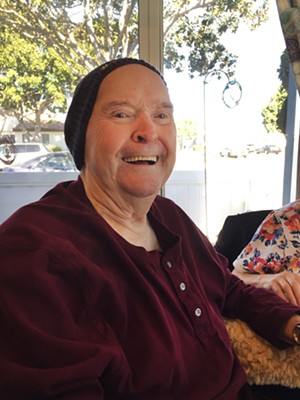Nipomo resident Janice LaMere found her life’s calling through an all-too-relatable personal ordeal.
When her father was diagnosed with Lewy body dementia in 2011, he moved into her house for long-term care. There was no better option—at least not one they could afford.
“My parents lived in Paso Robles and I lived in Nipomo,” LaMere explained. “They rented their house—they’re not rich, just living paycheck to paycheck. I told my mom, ‘You have to move here because I have my 5-year-old grandson living with me.’ I couldn’t run back and forth.”

After seven years of caring for her dad, as his declining condition grew too severe to safely manage anymore, LaMere made the gut-wrenching decision to move him to a care facility.
“I cried every night,” she said. “I was there [at his care center] eight-plus hours every day. Bottom line, my father lived for nine months. Out of this came A Bridge of Hope.”
Formally established as a nonprofit last year, A Bridge of Hope’s mission is to help subsidize and coordinate quality in-home care for local seniors, so they can stay in their own houses for as long as humanely possible.
A brainchild of LaMere and occupational therapist Alan Prince, a longtime in-home care professional, their model is simple yet novel: to fill the gaps in a system that leaves too many families with too few options for their aging loved ones.
LaMere said that unless a senior is wealthy, on Medi-Cal, or paid for long-term care insurance, affording private in-home care is often impossible.
“I really want the community to understand that there’s only two options for these people: You go to a care facility, or you have to move in with family,” she said. “Neither one of those are good options. We’re the third option.”
By leveraging its network of trained and vetted independent home health aides, A Bridge of Hope will help clients and their families determine the best care plan for them, and then subsidize that care to make it affordable.
“I’ve learned that the key to keeping people at home is to have the proper in-home support,” Prince, a 28-year veteran of the home health care sector, told the Sun. “If we don’t have the right support systems in place, our senior population will fail. They’ll fall. They’ll be hospitalized. They’ll end up being placed against their will sometimes.”
Throughout his career, Prince said that he’s seen up close the ways that the current system fails seniors. The main culprit, like LaMere noted, is cost.
“The private in-home providers charge anywhere from $30 to $40 per hour, and that is out of reach for many folks,” Prince said. “It’s either, ‘I eat and pay for medications, or I pay for a caregiver.’ We have to bridge this gap.”
While long-term care facilities play a needed role in the overall system, Prince said that a senior living at home, with physical help, is often the safest and happiest route.
“There is a place for the nursing homes, but it is a quality-of-life issue,” Prince said. “And you can look at the pandemic and how many people died in those [congregate] settings and could have been home and survived.”
With the community’s support, LaMere and Prince believe that they can use their combined passion and expertise to connect their clients to better solutions.
LaMere’s already been doing it for years. Since her dad passed away, she’s personally helped nearly 50 seniors with in-home care. Thanks to that experience, and her time in nursing homes with her dad, she’s friends with a community of home health aides who are working with the nonprofit.
“We’re all just women who had a passion,” she said.
A Bridge of Hope is currently accepting clients from Arroyo Grande to Lompoc. LaMere’s promise to clients is that they will be “treated with dignity, respect, and compassion.”
“The best thing about our job is I don’t ever feel like I go to work,” she said. “We’re there with them. We get to walk with them. We know they’re not alone and they’re taken care of.”
But A Bridge of Hope needs donations to be able to provide the subsidies and assistance that so many would benefit from.
“Right now, we need the support of the community to help us see this vision through. Nobody has done this before. This is a concept that doesn’t exist,” Prince said.
“There are thousands of clients in the county that would benefit from our services.”
Highlight
• The Lompoc Valley Chamber of Commerce is seeking vendors and sponsorships for the return of Old Town Market this summer. The event—which features different themes each week with live music, vendor booths, and free kids’ activities—is held on Friday evenings, July 7 through Aug. 11. Vendor registration is open until June 5. Booth space fees are $25 per night for chamber members and $35 per night for nonmembers. For more information, email Mayra Soto at [email protected] or call (805) 736-4567.
Reach New Times’ Assistant Editor Peter Johnson at [email protected].


